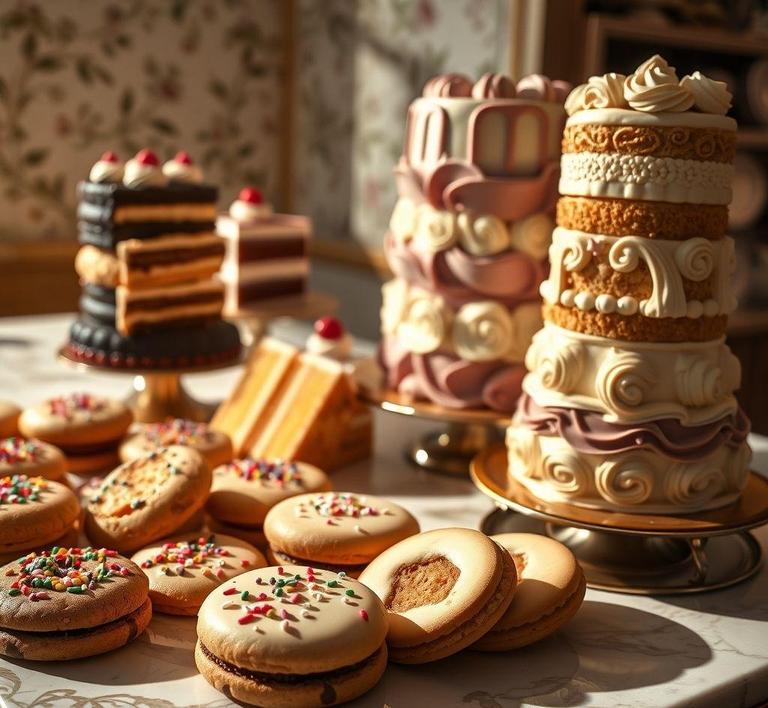If you’ve ever baked a batch of cookies or cakes only to find yourself with leftovers, you might be wondering whether you can refreeze them for later. The good news is, yes, you can refreeze cookies and cakes-but there are some tips and tricks to keep them tasting fresh and maintaining their texture. Refreezing these baked goods might sound like a simple task, but getting the best results requires a bit of knowledge on how to store them properly and when it’s best to freeze them again. In this guide, we’ll walk you through everything you need to know to ensure your treats stay just as delicious after the second freeze!
Can You Refreeze Cookies And Cakes?

Refreezing cookies and cakes is a topic that often sparks confusion and debate. After all, when something has already been frozen, then thawed, can it really be returned to the freezer without compromising its quality or safety? The good news is, yes, you can refreeze cookies and cakes – but with important caveats.
To start, it’s crucial to consider what kind of baked goods you’re working with. Most cookies and cakes can withstand being frozen, thawed, and refrozen, as long as the refreezing process is done properly. However, the quality of the final product may not always be the same as when it was originally frozen. This is especially true for cakes with cream-based fillings or frosting, which might not retain their texture or flavor after being frozen multiple times.
Another important aspect is the safety of refreezing. As long as the cookies or cakes have been stored at the correct temperature and haven’t been left out at room temperature for too long, refreezing should be perfectly safe. The key is not to refreeze items that have been sitting in the "danger zone" (between 40°F and 140°F) for extended periods, as this can promote bacterial growth. Additionally, if you’re refreezing leftovers from a thawed batch, make sure that the cookies or cakes were properly handled and haven’t been contaminated.
How To Refreeze Cookies And Cakes?
Refreezing cookies and cakes requires attention to detail, especially to preserve both safety and quality. Here’s a step-by-step guide to ensure that your baked goods freeze and refreeze successfully:
- Allow Complete Cooling: Before freezing or refreezing cookies or cakes, make sure they are completely cool. If the baked goods are still warm, they can produce condensation as they freeze, which will lead to sogginess or ice crystals forming within the texture. For cakes, let them cool for at least an hour; cookies can cool for 30 minutes.
- Proper Packaging: Good packaging is essential to prevent freezer burn and preserve flavor. Wrap individual cookies or slices of cake tightly in plastic wrap or aluminum foil. For cakes, it’s best to wrap them in a layer of plastic wrap followed by a layer of foil. For added protection, place them in an airtight freezer-safe container or a resealable freezer bag. The less air in the packaging, the better.
- Labeling: If you plan to refreeze your cookies or cakes, it’s a good idea to label the packaging with the date they were originally frozen. This helps keep track of how long they’ve been in the freezer, as baked goods are generally best used within three months for optimal quality.
- Thawing Before Refreezing: If you’re looking to refreeze your cookies or cake after they’ve been thawed, make sure they’re thawed completely before being refrozen. Do not refreeze any items that have been partially thawed and then refrozen. This can affect both the texture and safety of the baked goods.
- Re-freezing in Portions: If possible, freeze your cookies or cakes in small portions or batches so you only need to take out what you will use at any given time. This will minimize the need to thaw and refreeze repeatedly, which is especially important for maintaining texture and quality.
- Avoid Frosting Refreezing: If your cake is frosted with cream cheese or buttercream frosting, the frosting might break down or separate during the freezing process. It’s generally better to freeze the un-frosted cake and frost it once it’s thawed and ready to serve. Alternatively, you could freeze the frosting separately and apply it when thawing.
Quality Impact
The quality of cookies and cakes after being refrozen is a bit of a mixed bag. While the process doesn’t necessarily ruin them, there are several factors to consider in terms of texture, flavor, and overall presentation.
Texture
For most cookies, refreezing doesn’t lead to major texture issues. However, cookies with a high moisture content (like soft-baked varieties or ones with filling) may lose some of their original crispness and become softer or even soggy. This is especially true if they weren’t properly wrapped or sealed during freezing. Cakes, on the other hand, tend to fare a little worse when refrozen. A cake’s crumb structure can become slightly denser or drier, especially if it wasn’t wrapped well or if it contains ingredients that don’t freeze well, like fresh fruits or cream fillings. Additionally, frostings on cakes can lose their smooth, fluffy texture, particularly when cream-based.
Flavor
Freezing and refreezing generally doesn’t affect the flavor of cookies or cakes too dramatically, but if they’ve been frozen for an extended period or if the freezing process wasn’t done properly, you might notice a decline in taste. The air in the freezer can cause a phenomenon known as “freezer burn”, which can negatively impact the flavor, making them taste stale or bland. Additionally, the flavors in cakes that have fillings, icings, or fruits may become muted or a bit muddled after multiple freezing cycles.
Moisture
When cookies and cakes are thawed and refrozen, moisture can be trapped inside and redistributed, leading to uneven texture. In cookies, this could mean a shift from being crunchy to soft, and in cakes, it might result in a denser, soggier product, especially if they weren’t tightly wrapped during the freezing process. To counter this, be sure to seal baked goods tightly to lock in moisture and prevent the ice crystals from forming.
Appearance
Aesthetic changes are also possible. For cakes, refreezing can lead to a loss of their original shape, especially if the frosting or toppings are affected by condensation or ice crystals. Frosting may melt or become sticky and lose its glossy finish. For cookies, while they are less prone to changes in appearance, they may lose their initial crisp golden-brown edges or get a bit flattened due to moisture buildup.
While you can refreeze cookies and cakes, the decision largely depends on the type of baked goods you’re working with, how they were stored, and how much you value quality. For best results, ensure that they are properly cooled, tightly wrapped, and stored in an airtight container to minimize any negative effects. Although refreezing won’t ruin your cookies and cakes outright, it can impact their texture, flavor, and appearance, so it’s important to assess whether the tradeoff is worth it.
If you’re planning to store baked goods for a longer period of time, freezing them initially is a great way to preserve them. However, remember that the more times you freeze and thaw, the greater the chance of compromising the quality. To maintain optimal results, try to only freeze and thaw your baked goods once, and if necessary, freeze smaller portions to avoid the need for frequent refreezing.
Is It Safe To Refreeze Cookies And Cakes?
The process of freezing and refreezing baked goods like cookies and cakes is not as simple as it might seem, especially when it comes to preserving their taste, texture, and overall quality. While the act of refreezing itself does not necessarily pose a safety risk, there are several factors to consider before putting those baked delights back in the freezer.
Safety Concerns:
The primary concern with refreezing cookies and cakes is not typically foodborne illness, but rather the degradation of texture and flavor. When cakes and cookies are frozen, their moisture content changes, which can lead to a loss of freshness. If these baked goods have already been thawed, they may start to absorb moisture from the air when left at room temperature, creating a perfect environment for bacterial growth. However, if your cookies and cakes were thawed at a safe temperature-meaning they were kept either in the fridge or at room temperature for no more than two hours-then refreezing should be safe in terms of food safety, assuming all handling steps were done properly.
It’s important to remember that freezing does not kill bacteria; it simply puts it to sleep. So, as long as you’re mindful of proper handling and storage, there should be no health risks associated with refreezing. The challenge lies more in maintaining the texture and flavor of your cookies and cakes after they’ve gone through the freezing and thawing cycles.
Signs That Cookies And Cakes Should Not Be Refrozen
While refreezing cookies and cakes is generally safe when handled correctly, there are certain signs that indicate it may be best to avoid refreezing altogether. These include:
-
Off Smell or Taste:
If your cookies or cakes have been left out too long or thawed improperly, they may start to develop an off smell or taste. This is a clear sign that they’ve begun to spoil, and refreezing would only trap those unwanted flavors, making them even less appetizing after the second round.
-
Soggy Texture:
A major issue with refreezing is the impact it has on the texture of baked goods. Cookies and cakes, especially those with a delicate crumb, will likely become soggy or dry after being frozen, thawed, and refrozen. If your cookies or cakes feel mushy, wet, or unpleasantly dense after the first thaw, it’s a good indication that refreezing will only make them worse.
-
Separation of Frosting or Fillings:
Cakes and cookies with frostings or fillings, particularly those with cream cheese, butter, or whipped cream, can suffer from separation after thawing. If you notice that your frosting has begun to separate or become watery, it’s best to avoid refreezing these baked goods. Refreezing will likely exacerbate this issue, leaving you with an unappealing texture and appearance.
-
Cracking or Crumbling:
If your cakes or cookies begin to crack, crumble, or lose their structural integrity after thawing, it’s a clear sign that they have been subjected to too much moisture change. Refreezing in this state would only intensify the damage, resulting in baked goods that fall apart at the slightest touch.
-
Discoloration:
Discoloration can be an indication that the moisture content in your baked goods is too high, leading to freezer burn or a breakdown of ingredients. If you notice any strange discoloration, especially in the frosting or fillings, it’s better to discard the item than attempt to refreeze.
Common Refreezing Mistakes
When it comes to refreezing cookies and cakes, several common mistakes can make the process less successful. Here are some of the key pitfalls to avoid:
-
Thawing at Room Temperature for Too Long:
One of the most common mistakes is leaving cookies and cakes out at room temperature for longer than the safe window (usually no more than two hours). When you allow your baked goods to thaw too long, bacteria can begin to grow, which not only affects food safety but also leads to poor texture and flavor. Thaw baked goods in the fridge if you’re not planning on eating them right away.
-
Not Wrapping or Storing Properly Before Freezing:
Baked goods should always be wrapped tightly in plastic wrap, aluminum foil, or placed in airtight containers before freezing. If not properly sealed, they will be exposed to air and moisture, leading to freezer burn or a dry, crumbly texture when thawed and refrozen. Double-wrap your items if you plan to freeze them multiple times for better protection.
-
Freezing Frosted Cakes or Cookies Immediately:
Frosting tends to not freeze as well as the cake or cookie itself. It can separate, become watery, or even freeze into a grainy texture. If you plan to refreeze frosted cakes, it’s best to freeze them uncovered until the frosting hardens, then wrap them securely. This will prevent the frosting from getting ruined during the freezing process.
-
Refreezing After They’ve Been Thawed for Too Long:
Refreezing cookies and cakes that have been left out for too long is a bad idea. Not only does it impact their texture and taste, but it can also compromise their safety. Make sure your baked goods haven’t been thawed for more than 2 hours at room temperature before you decide to refreeze them.
-
Overloading the Freezer:
If you have a lot of cookies or cakes to refreeze, try not to overload your freezer. Baked goods need sufficient airflow to freeze properly. Overcrowding your freezer can cause uneven freezing and might even prevent the cakes or cookies from freezing quickly enough, leading to changes in texture and quality.
Tips And Tricks
If you’re determined to refreeze cookies and cakes, there are a few strategies you can use to maximize the chances of success:
-
Wrap Each Item Individually:
If you have multiple cookies or slices of cake to freeze, wrap each one individually. This will allow you to take out just what you need without exposing the rest to air, which can cause them to dry out or absorb moisture.
-
Freeze in Layers:
If you are freezing cakes or cookies that are stacked, place a layer of parchment paper or wax paper between each item. This prevents them from sticking together and makes it easier to remove just what you need without damaging the rest.
-
Use Plastic Wrap, Then Aluminum Foil:
For extra protection against freezer burn, wrap your cookies or cakes first in plastic wrap and then in aluminum foil. This double layer prevents the food from drying out or absorbing any freezer odors.
-
Consider Freezing the Cookie Dough Instead:
Instead of freezing already-baked cookies, freeze the dough itself. Cookie dough generally freezes better than baked cookies, maintaining its texture and flavor once baked. You can scoop out dough portions and freeze them in a single layer, then transfer them to an airtight container. When you want fresh cookies, just bake them directly from frozen!
-
Thaw in the Refrigerator:
When you’re ready to thaw your baked goods, do so slowly by placing them in the refrigerator overnight. This prevents rapid changes in moisture levels that can ruin texture and taste. For quicker thawing, leave them at room temperature for no more than an hour.
Conclusion
Refreezing cookies and cakes is definitely possible, but it requires careful handling to preserve their quality. While there are no major safety concerns as long as they’ve been thawed and stored correctly, the primary challenge is maintaining the original taste and texture of your baked goods. By watching for signs that your cookies or cakes should not be refrozen-such as off smells, sogginess, or texture issues-you can avoid a disappointing outcome. Taking the time to properly store and handle your baked treats before and after freezing is key to enjoying them at their best, even after they’ve been frozen and thawed. And if in doubt, freezing the dough rather than the final product can often be a more reliable way to preserve freshness for the future.


